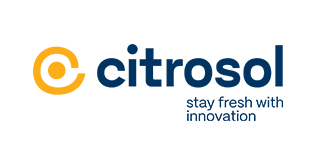

Citrosol
Phytosanitaries
Recommendations for Cold Storage of Late-Season Oranges
By Dr. Celia Murciano and Dr. Rafael Torregrosa, Technical Department of Citrosol

Cold storage of late-season oranges for prolonged commercial periods involves implementing various post-harvest treatments. The goal of these treatments is to prevent decay, maintain fruit quality, minimize weight loss, and reduce chilling injury from low storage temperatures.
Drencher Treatments
During cold storage, one of the biggest problems is decay caused by blue mold, Penicillium italicum, as this fungus can grow at temperatures close to 0˚C and spread through contact, forming infection nests. To prevent its occurrence, it is crucial to apply an effective drencher treatment that can eradicate incipient infections and prevent the development of subsequent infections. Additionally, establishing good Cleaning and Disinfection (C&D) practices is vital, as described later. At CITROSOL, for extended cold storage, we recommend using a complete drencher treatment that combines products with different functions (Table 1). If the fruit treatment is done on the line, using a treatment with two or three substances is also advisable for more robust results.
Table 1. Drencher Treatment in Cold Storage
|
Product |
Function |
|
IMACIDE® 7,5 LS |
Fungicide |
|
CITROPYR 40 SC or ORTOCIL |
Fungicide |
|
FUNG-CID GRAS SP |
Booster for cold storage |
|
CITROPROTECT PLUS |
Skin protector |
|
CITROCIDE® PLUS |
Treatment solution sanitizer |
Coatings Against Chilling Injury (CI)
Generally, the use of waxes and coatings reduces the incidence of CI. Coatings for preservation are designed to extend the commercial life of citrus fruits after long periods of low-temperature storage, allowing gas exchange, preventing dehydration, and protecting the fruit from chilling injury. Depending on customer needs, CITROSOL offers a range of coatings with different certifications (Table 2).
Table 2. Coatings for cold storage
|
Coating |
Composition |
Weight loss Control (%) |
Certified as |
|
Citrosol A CAM UE |
P + S |
Very Good |
- |
|
Sunseal Vegan |
P + K |
Very Good |
Vegan |
|
Plantseal |
K |
Excellent |
Ecologic & Vegan |
|
P – Oxidized polyethylene / K - carnauba / S – shellac |
|||
Storage and Transport Conditions
For Valencia oranges, the most suitable storage conditions are 4-5˚C, with 90% relative humidity and a CO2 concentration of less than 2000 ppm. Additionally, during cold storage, reinforcement treatments can be performed using either FRUITFOG-I, a fog treatment, or GREENFOG-AS, a fog treatment with food additives (E-200), to increase control over major post-harvest decays.
C&D Protocols
During prolonged cold storage periods, it is vital to reinforce C&D protocols throughout the facility, especially in the chambers designated for storage before beginning it.
First, a thorough cleaning of all areas in the chamber is recommended using an alkaline detergent like Citrolen Fuerte, followed by rinsing with a water solution and Greencare-PH, a disinfectant with hydrogen peroxide.
Next, the chamber disinfection can be performed, always in the absence of fruit, using Quacide PQ60 EC, a broad-spectrum biocidal disinfectant of tertiary amines and polymeric biguanides, applied with the X3 Nebulizer, or using the Despray-Da equipment and the glutaraldehyde-based disinfectant Oxa-Biocid Eco, always rinsing afterward with tap water.
To complete the disinfection, we also recommend using, in the absence of fruit, the disinfectant fumigant Fumispore®, a glycolic acid formulation with fungicidal and bactericidal action.












